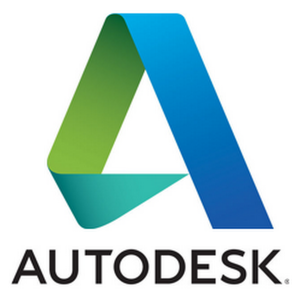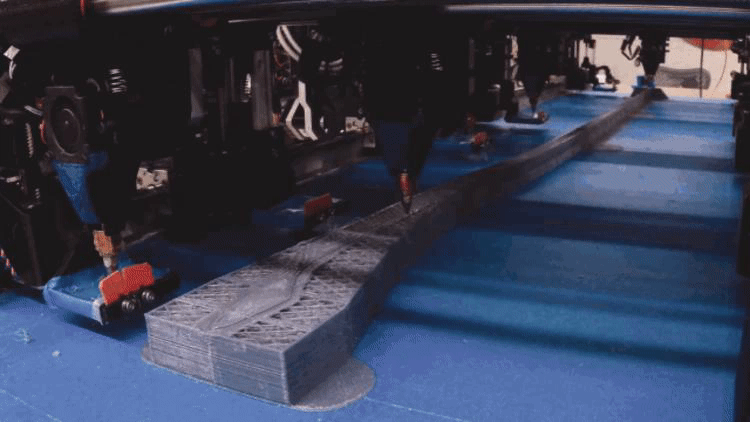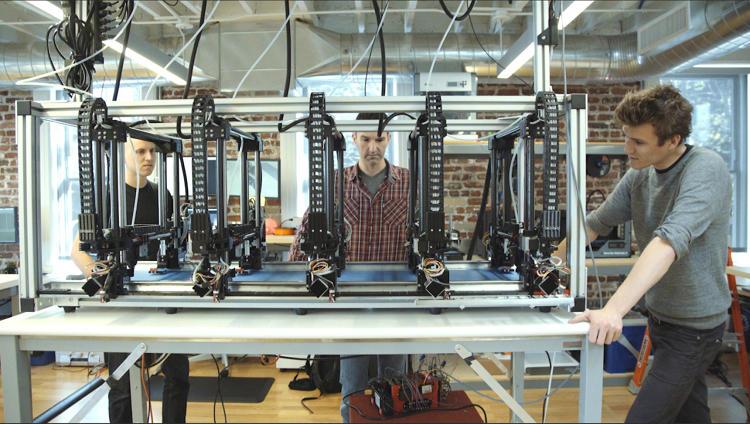 One of the drawbacks to using 3D printing for manufacturing is the time that it takes to print each object. When a product is being mass produced, standard injection molding can produce the part in seconds, while a similarly shaped object often takes hours to 3D print. And the larger the object, the longer that it takes to print. For a truly large-scale object like a full-sized car or the blade from a turbine it takes days, even weeks depending on how much material is being used. Despite 3D printing being amazing technology, the way that it currently works simply makes it impractical for a lot of industrial or mass production applications.
One of the drawbacks to using 3D printing for manufacturing is the time that it takes to print each object. When a product is being mass produced, standard injection molding can produce the part in seconds, while a similarly shaped object often takes hours to 3D print. And the larger the object, the longer that it takes to print. For a truly large-scale object like a full-sized car or the blade from a turbine it takes days, even weeks depending on how much material is being used. Despite 3D printing being amazing technology, the way that it currently works simply makes it impractical for a lot of industrial or mass production applications.
As with a lot of the problems that face 3D printing, Autodesk believes that the best way to solve it — in this case to optimize and speed up the process — is just a matter of developing the right software. Project Escher is the Northern California-based software developer’s attempt to do just that. The Project Escher software is an advanced control technology that was made to coordinate the movements of an entire bank of 3D printing heads. When these multiple printing heads are tied together, the Project Escher software can get them to work in unison to print huge objects all at the same time, which exponentially speeds up the printing process.
A 3D printer that is controlled by the Project Escher software will print a large object using its multiple printheads up to 80% to 90% more efficiently than printing it with a single printhead. For each printhead that is networked together, the entire printing process is sped up, so if the 3D printer has five printers then the entire object will be printed four to four and a half times faster than if a single printer did it. The control and coordination of the printing heads is so precise that the entire huge part is printed together, with each head laying layers of plastic down on top of each other’s layers so everything will end up as a single complete piece.
When a huge part needs to be 3D printed, the Project Escher software takes the 3D model and divides it up into individual parts for each printhead, called a “bot”. Each individual part is then assigned to a specific bot and then sliced as normal. When the printing process begins, each bot will be interlacing their layers together while avoiding each other throughout the process. According to Autodesk there are no limits to the number of bots that can be connected, so there virtually is no limit to the size of the object that can be printed. The bots are suspended over the printing surface with a gantry, and it can hold a limitless number of printheads or, according to Autodesk, almost any kind of robotic arm or toolhead.
Autodesk calls each bot a conductive player, and likens them to members of an orchestra that will be playing individually, but in service of a coordinated effort to blend several individual sounds together. Obviously the Project Escher software is not for the desktop or hobbyist market, but is meant as an industrial application. The software can be used in a wide variety of industrial settings, so large-scale parts that would typically take days can be done in hours. And because there is no cost for customization, each large part that is 3D printed can be customized for a specific user or application.

The Project Escher Software can control multiple printheads to coordinate their efforts and speed up the printing process.
Here is a video describing Project Escher and demonstrating the giant five-printhead 3D printer that they built to test it:
Beyond 3D printing, the software can control any type of toolhead that can be supported by the gantry. That means that potentially large parts could be wired, have conductive filaments printed into them, or even have a pick and place arm included to embed electronics into the object as it is being printed. The software can control an entire assembly line, and that assembly line can be made versatile enough that almost anything can be fabricated on it using a wide variety of materials, tools and components. Project Escher is turning 3D printing into a one stop manufacturing system, and there are virtually no limits to what it can do. You can find out more about Project Escher here. Discuss further in the Project Escher & 3D Printing forum over at 3DPB.com.
Subscribe to Our Email Newsletter
Stay up-to-date on all the latest news from the 3D printing industry and receive information and offers from third party vendors.
You May Also Like
3D Printing Unpeeled: Orbex Investment, IndoMIM and HP, Ultrasonic Waves
INDO-MIM has bought three HP Metal Jet S100 printers, operating two in India and one in Texas. This is a win for HP because the company has deep experience in...
Seurat CFO Di Paola Shares Insights on Defying Industry Trends in 3D Printing
In an industry where 3D printing public companies are grappling with troubled earnings and workforce reductions, Seurat is defying market trends by increasing its workforce sevenfold, growing from 20 to...
AMCM Debuts 8-Laser Metal 3D Printer for Prometheus Rocket and Forges Partnership with Sintavia
EOS sister company AMCM has unveiled its upcoming M 8K laser beam powder bed fusion (PBF-LB) metal AM machine. It is expected to launch by the end of 2024. Building...
Daring AM: ArianeGroup Advances Europe’s Reusable Rockets with Successful Testfire
Despite setbacks in the global space industry, such as Relativity Space’s recent failure to launch a 3D printed rocket and the closure of Virgin Orbit, European Ariane rockets are gained...
































